The biggest entertainment stories
Get our big stories about Hollywood, film, television, music, arts, culture and more right in your inbox as soon as they publish.
You may occasionally receive promotional content from the Los Angeles Times.
It measures only 8 feet by 8 feet. But to Stephen Smith, the tiny red house in North Hollywood is the place he calls home.
Until early last month, Smith had been living out of his car in locations around the San Fernando Valley, collecting cans from city parks as a way of making spare change. He ended up on the street not through a single event, but a slippery chain of them: the death of his mother last year followed by the pandemic, which left him in an emotional and economic lurch.
“Me and my mom were best friends,” he says. “I took it kind of bad.”
After a year on the streets, however, Smith was ready for a change. When a caseworker from the Los Angeles Homeless Services Authority approached him with an offer of shelter over the winter, he took it. “I said, ‘Let’s get with it,’” he recalls. “God helps those who help themselves. This is Stephen 2.0.”
The caseworker connected him with Chandler Street Tiny Home Village in North Hollywood, a shelter that is the first of its kind in Los Angeles.
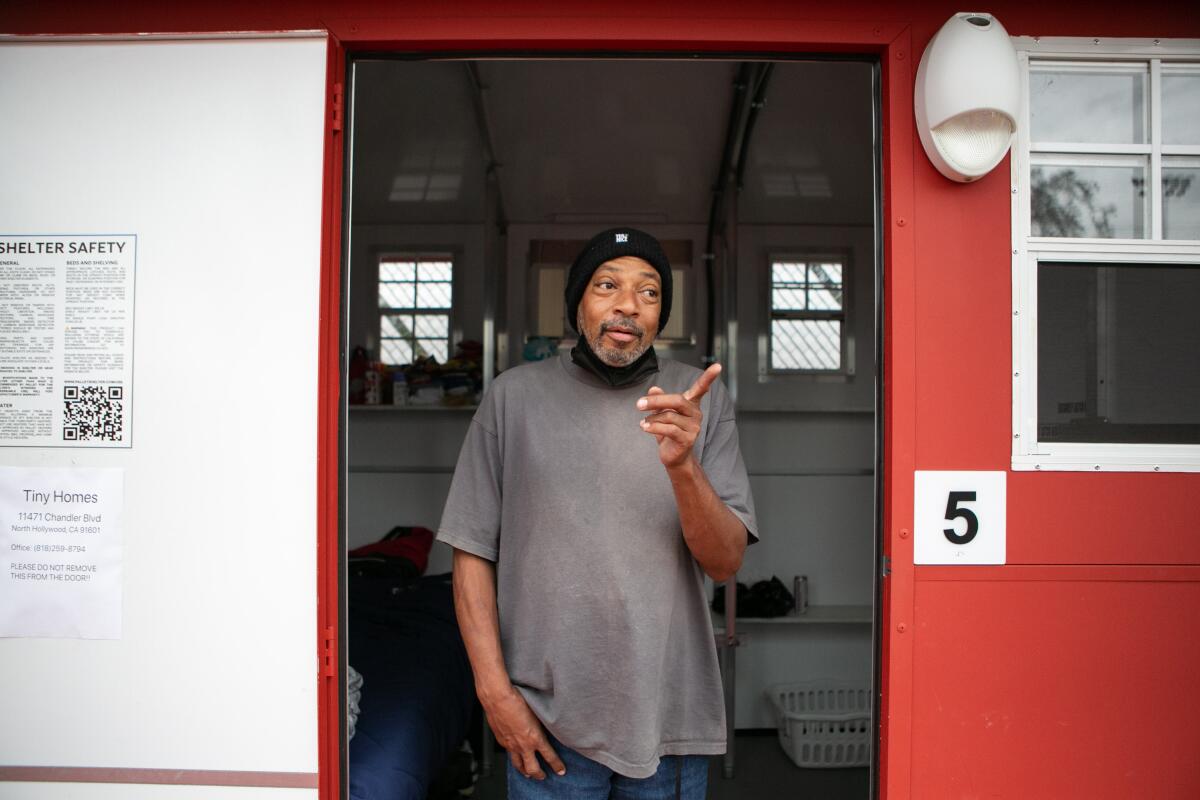
Instead of a bed in a dorm, Smith was assigned his own freestanding tiny home. The dwelling does not have a bathroom — those are shared, along with a laundry facility and a kitchenette. But otherwise, Smith’s space is his own.
“I wouldn’t change nothing,” he says of the structure’s design. “I don’t see any improvements I could make.” Though he does say the village could use more bathrooms.
L.A.’s elected officials see the shutdown of an Echo Park encampment as a success. The homeless people who ended up in hotels don’t agree.
Chandler Street, which is operated by Hope of the Valley Rescue Mission, is an interim housing shelter designed for stays of three to six months — a site that helps clients get back on their feet as they seek other housing. On-site caseworkers assist with basics such as securing paperwork to recover lost IDs, connecting people to basic services, and providing a steady address as they apply for jobs or benefits.
“It’s a spot to stabilize,” says Laurie Craft, Hope of the Valley’s chief program officer. “So that when people move into permanent supportive housing, the result is good.”
Smith’s first order of business is getting his cellphone turned back on so that he can be ready to work. His dream is a gig in car restoration. His specialty: “Anything GM.”
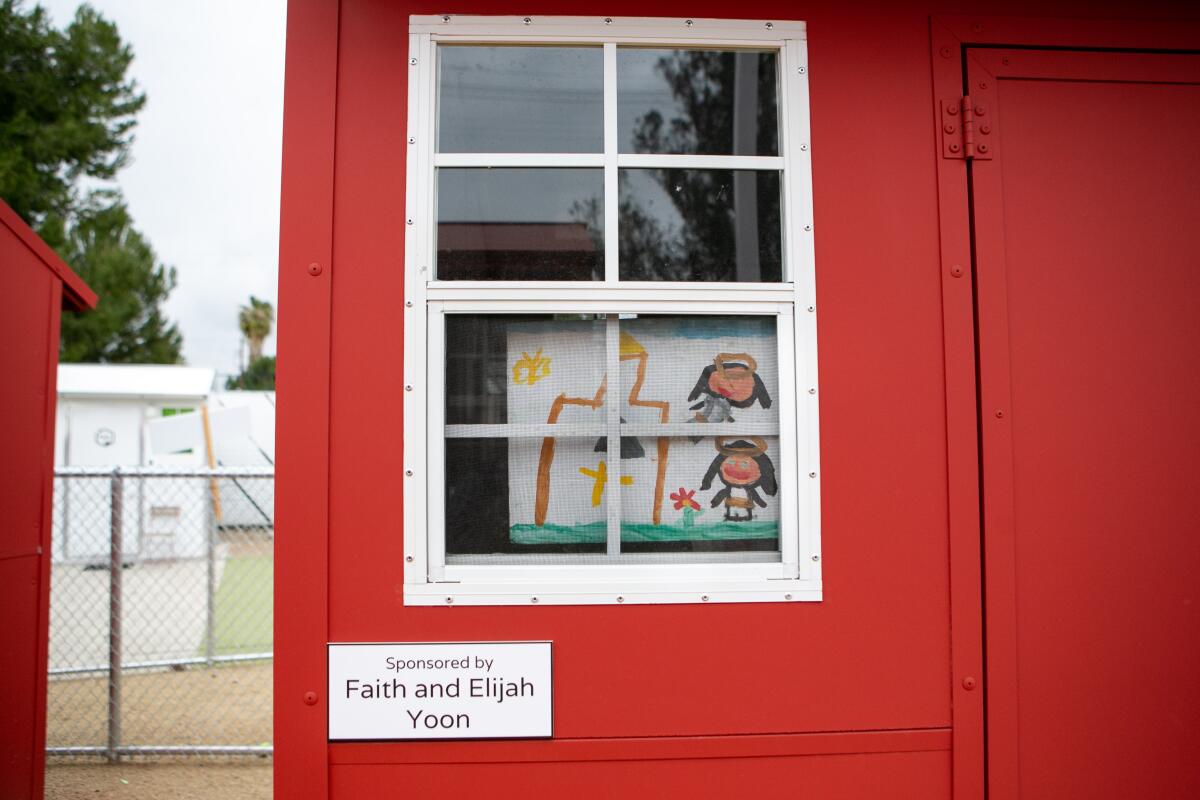
The pandemic has brought with it numerous reckonings. Among them, the moral question of how a society as wealthy as our own shelters the unhoused. Central to that question are issues of politics, policy and design, and how they come together to create solutions that are long-lasting. Design is a critical piece — since what a shelter looks like and how it functions can help determine whether it is successful in getting a client to stick around.
And in Los Angeles, there couldn’t be a more critical time to grapple with these issues than this moment.
Is a tiny house really a glorified tool shed? Does living in a shipping container feel like ... living in a shipping container?
In late March, the punitive eviction of an estimated 200 people from a long-running encampment at Echo Park Lake generated national headlines. That was followed by a report, commissioned by the U.S. Department of Health and Human Services and the Department of Housing and Urban Development, which shows that encampment removals are not only extraordinarily costly, but they also don’t work. As one encampment is razed, others pop up elsewhere — turning the already tenuous existence of the unhoused into a vicious circle of relocation.
Furthermore, the Los Angeles City Council appears headed toward a settlement of a federal lawsuit that would require shelter to be provided for thousands of homeless people living around freeways. What form these shelters might take remains unknown. But whatever their shape, they will need to be erected quickly. Very quickly.
For the city and the county, this means finding land and cutting bureaucratic red tape so that projects can be more speedily approved and built. Already, there is experimentation with modular houses and recycled shipping containers in sites around Los Angeles. These can shave months off the building process, since they can be assembled on site — sometimes over parking lots and other terrain that would have required extensive preparation otherwise.
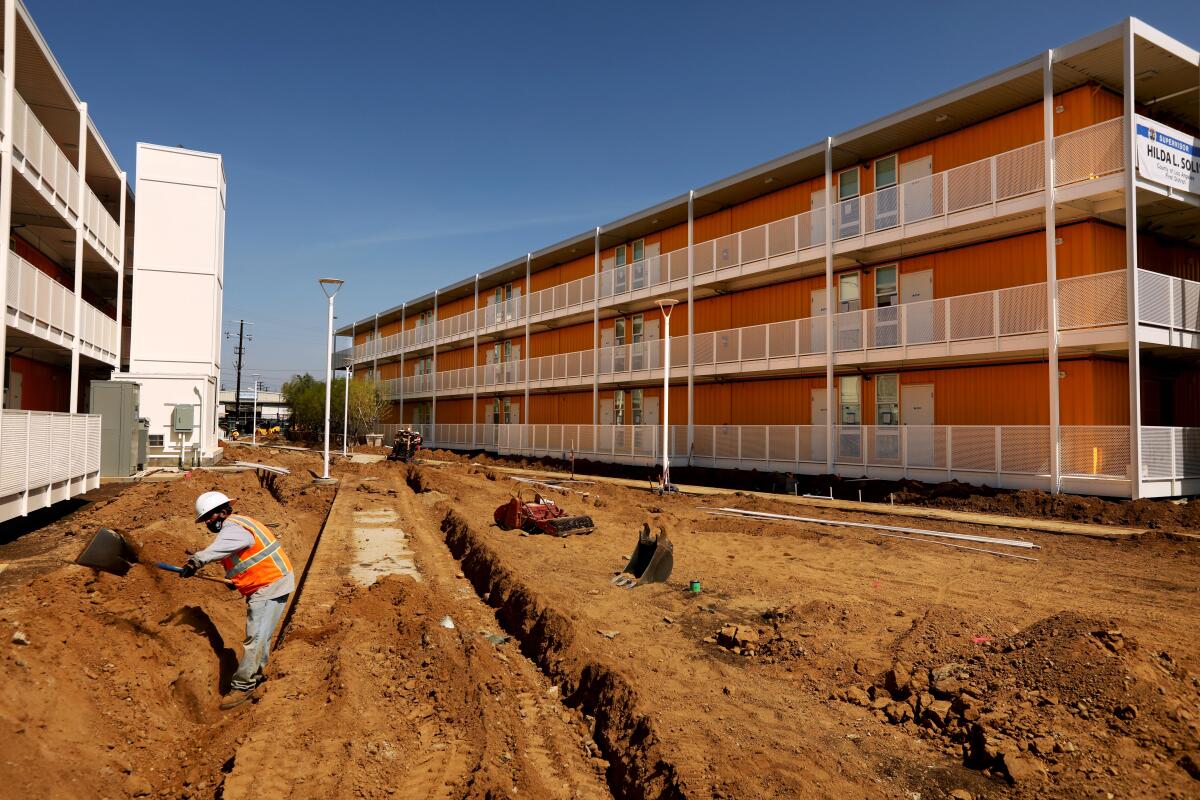
Chandler Tiny Home Village, which was designed by the Los Angeles firm Lehrer Architects, opened in February.
The village — which cost $4.4 million to build — occupies a teardrop-shaped sliver of city land tucked along the Orange Line busway at Chandler Boulevard and Tujunga Avenue. In a previous life, the parcel was a weed-strewn lot and graffiti magnet. “It was a useless piece of land made more useless because of its shape,” says architect Michael Lehrer, his firm’s namesake and founder.
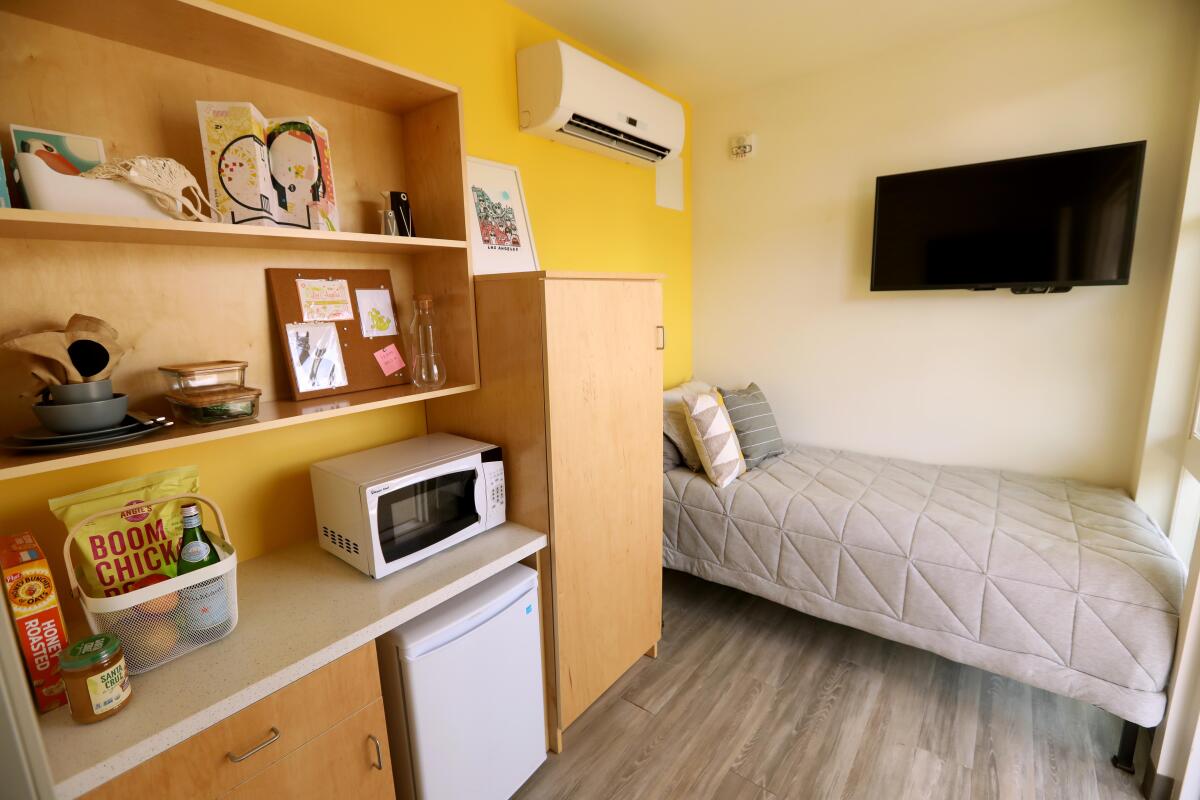
Now the site harbors 39 bright prefab tiny homes manufactured by Pallet, a company based in Everett, Wash. The pitched-roof units resemble storybook houses and sleep up to two people. They are arranged around a forked path that also contains a picnic area and a dog run. (A critical component in being more hospitable to the unhoused: not forcing them to separate from beloved pets.)
Lehrer Architects is also at work on a site in Alexandria Park in North Hollywood (with 103 tiny homes), which is set to accept clients at the end of the month, and another on Alvarado Street and Scott Avenue in Echo Park (39 units), which should open its doors in May.
In addition, Lehrer has designed communal shelters, including the Aetna Bridge Homes project in Van Nuys, which offers dormitory-style accommodations within a series of interlocking portable buildings. But the architect is more intrigued by the possibilities of tiny houses.
“Every individual gets their own home and it has a door and they can lock it, and that’s huge,” says Lehrer. “It’s a safe space.”
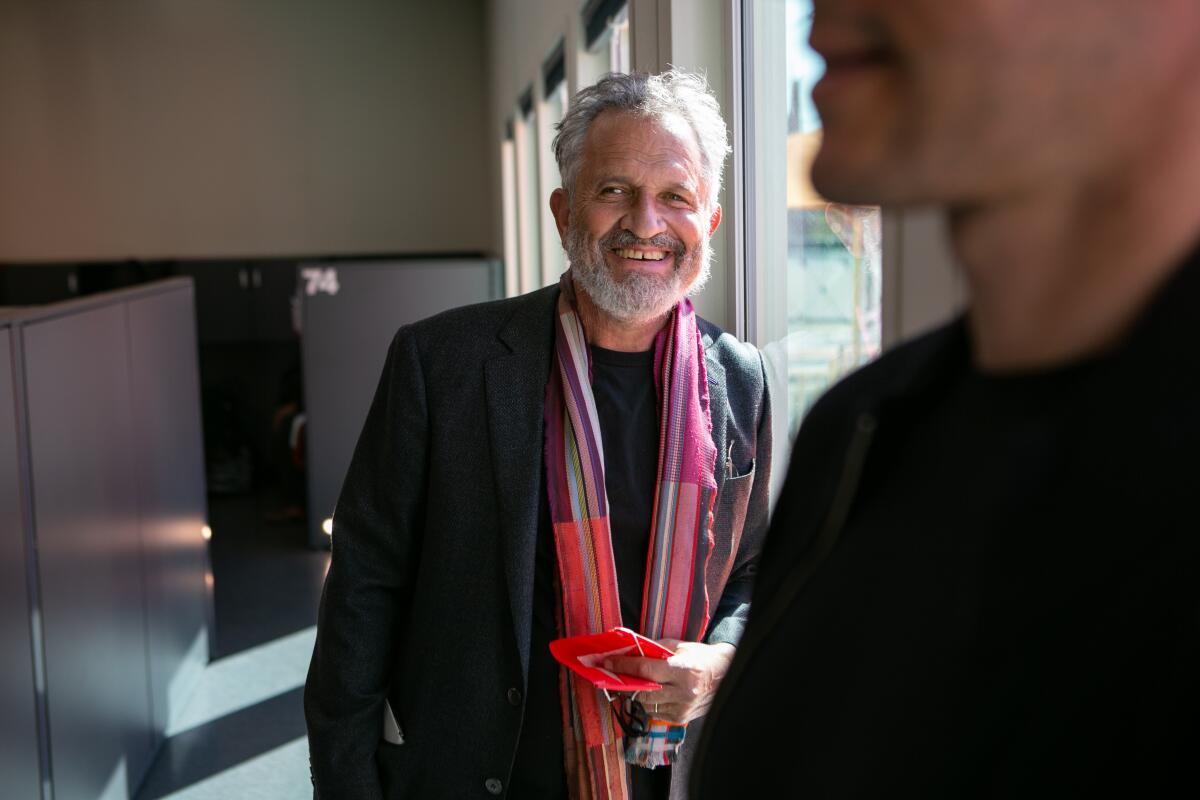
Architects are also experimenting with shipping containers.
On Vignes Street in downtown Los Angeles, construction crews are putting finishing touches on a county project formally known as the Hilda L. Solis Care First Village, a $57-million interim housing project that includes a mix of shipping container apartments and portable buildings (each with private bath) that can shelter 232 people.
The development, which occupies an industrial site that was most recently a parking lot for the L.A. Sheriff’s Department, was designed by NAC Architecture, with shipping containers refurbished by Crate Modular, a company based in Carson. It has gone up in record time: County Supervisor Hilda Solis initiated the project at the end of September. By October, it was under construction. This month, Care First Village will accept its first clients.
Dealing with homelessness by forced removal doesn’t work. Plus, equity at the Huntington, Amy Sherald’s first West Coast show.
In South Los Angeles, the nonprofit developer Clifford Beers Housing is transforming an awkward triangle of government land on Imperial Highway, near the intersections of the 110 and 105 freeways, into a shipping container development that will contain 54 units of permanent supportive housing.
Lorcan O’Herlihy Architects is designing the $12 million project, called Isla Intersections, which is in the early stages of construction and should be completed by the end of the year.
“The critical aspect is time,” O’Herlihy says. “We were able to build the modules while they were pouring foundations. You save about eight months.”
Time is of the essence — as is cost.
But my burning question has been: What exactly are these spaces like to live in? Is a tiny house really a glorified toolshed? Does living in a shipping container feel like ... living in a shipping container? And are we asking the unhoused to serve as guinea pigs in design experiments that look great as renderings on architecture websites, but are perfectly dreadful once you set foot in the door?
With those questions in mind, I went to visit these sites — all of them. My initial takeaway: I’m impressed.
On the shipping container front, I’d been expecting dank and steely. I am happy to discover I was wrong. Once containers have been refurbished with drywall and have had windows cut into them, they look and feel like any other domestic construction. Although the spaces are small — Care First Village‘s 135-square-foot rooms feel like a compact dorm room — the architects took extra care to cut large windows into the units to make these modest spaces feel airier.
The tiny homes, while more ephemeral in nature, are smartly designed: Each comes with four sets of windows to allow for light and cross ventilation, as well as individual heating and air conditioning units. In addition, the pitched roofs give the structures a good amount of head space. At Alexandria Park, I lay down inside one of the uninhabited units expecting a coffin-like vibe. Instead, the dimensions were more along the lines of a small rustic cabin.
Architectural designer Demar Matthews is using the Black vernacular — language, art, landscape, even hairstyles — to inform his work.
Even with limited time and even more limited resources, the architects have found ways to introduce aesthetic play into this work. As Lehrer Architects partner Nerin Kadribegovic says, “How do you fit all of this onto a constrained site and then add a little bit of something to make a place of desire?”
That desire comes from preserving existing trees for improvised park areas and bright color palettes. The splashes of red, pink, yellow and blue give the sites a vibe that is less FEMA shelter and more picturesque village.
“Asphalt and chain link are hard things to overcome,” says Lehrer. “It’s like, if there is asphalt and chain link, this is not a place that honors and respects people.”
“Color is not trivial,” he adds. “It is fundamental.”
Architects have also pushed the city and the county — along with private patrons — to do more.
Lehrer Architects got a private donor to supply the Chandler site with umbrellas to shade outdoor common areas — critical in the San Fernando Valley, where summer heat is epic.
When O’Herlihy began work on the nearly 20,000-square-foot site that will house Isla Intersections, it quickly became evident that the narrow, triangular site wouldn’t be able to accommodate much in the way of green space. So his firm, along with the leadership at Clifford Beers Housing, pressed the city to convert an adjacent lane, whose sole purpose is allowing cars to make a right turn onto Imperial Highway, into a pedestrian park. They then got the Annenberg Foundation to fund the construction of the park to the tune of $2.5 million.
O’Herlihy then staggered the layout of the container units so that he could fill in-between spaces with vegetation, which will function as a critical sound buffer. “This is an asphalt jungle,” he says. “If you can grab back the space from the road, the world will be better.”
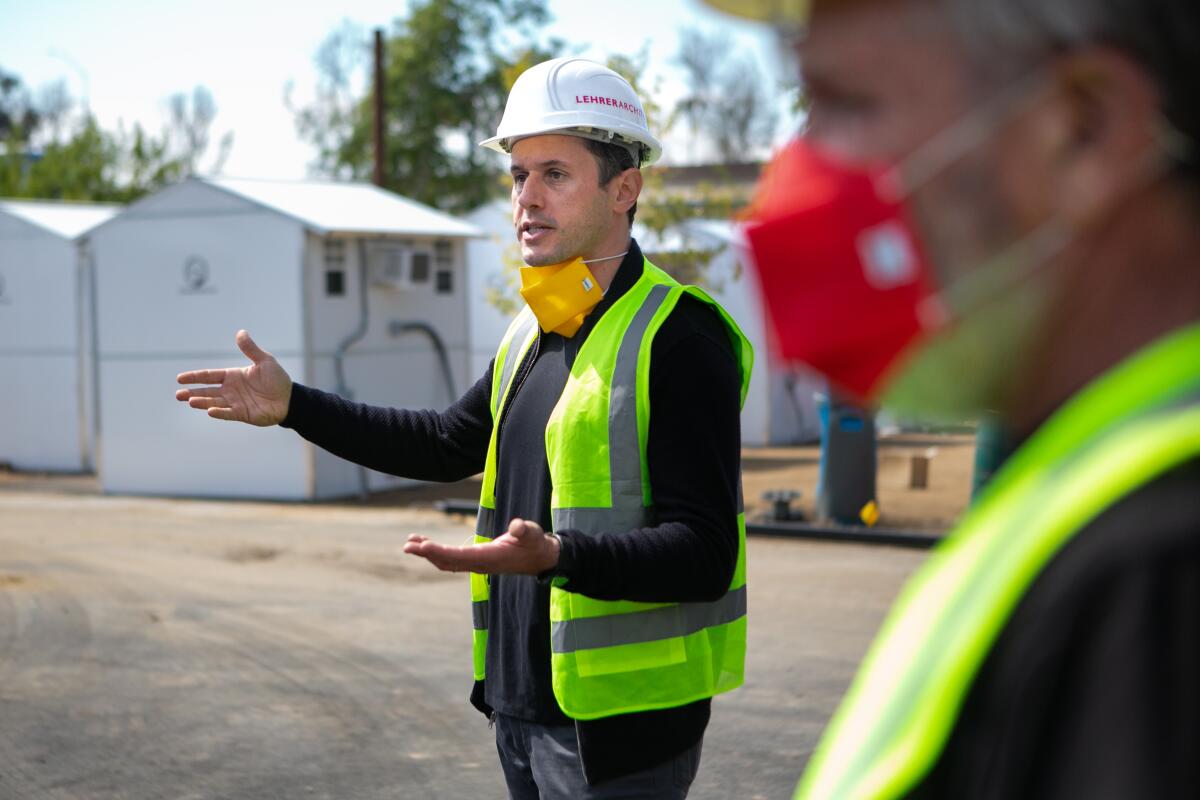
Creating humane outdoor spaces was also critical to architect Louise Griffin, who served as project manager for NAC Architecture on the design and construction of Care First Village in downtown. “The rooms are small, so it was important to make the courtyards a place you could socialize,” she says.
Courtyard areas will include trees and raised planters with fragrant herbs such as rosemary. Like the tiny home villages, color plays an important role. The architects painted the shipping containers sherbet-y shades of yellow and orange. “The containers are industrial,” says Griffin. “We wanted to make them less industrial.”
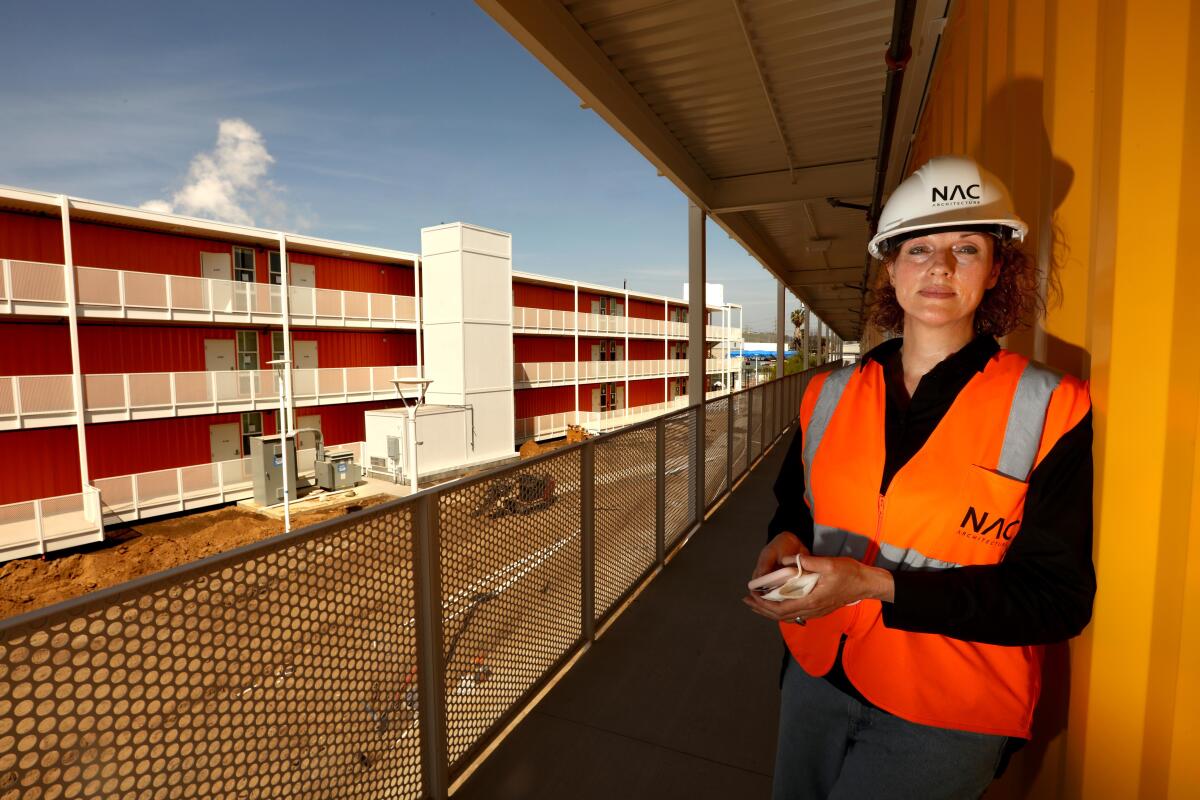
Michael Pinto, a principal at NAC Architecture, says it’s about creating a setting that feels like home, not a punitive institution. “What options do we have that isn’t jail?” he asks rhetorically. “Can we stop criminalizing homelessness?”
Lehrer says good design isn’t ancillary to these issues. “Design excellence is central,” he says emphatically. “This is important for the people [shelters] serve and it’s important for the neighborhoods they serve and it’s important for the culture — that we can honor our sisters and brothers and bring them into the community.”
Los Angeles has launched a program with over a dozen preapproved designs from top architects for backyard dwellings, cutting the bureaucracy for needed housing.
This is architecture, after all, that at some point in our lives, for reasons that may be beyond our control, we may find ourselves inhabiting.
Smith, for one, never imagined he’d live out of his car. “For people who got their noses up in the air,” he says, “this can happen to anybody.”
The biggest entertainment stories
Get our big stories about Hollywood, film, television, music, arts, culture and more right in your inbox as soon as they publish.
You may occasionally receive promotional content from the Los Angeles Times.